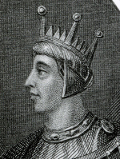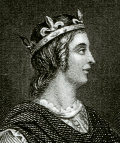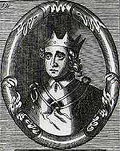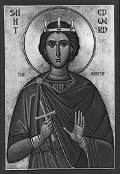Eadred, Eadwig, Edgar the Peaceful, and Edward the Martyr all ruled England for a time in the 10th Century.
Eadred
Another in the list of short-reigning Kings of England was Eadred, whose major accomplishment was bringing all of Northumbria under his sway.

Born in 923 as the second son of Edward the Elder, he succeeded his older brother, Edmund I on the throne in 946. Conflict with Northumbria started right away, and Eadred came up against the fearsome Eric Bloodaxe of Norway. Eadred was successful in taking Northumbria from the Norwegian and then ravaged the countryside, including the monastery at Ripon, in order to convince the Northumbrians to accept the English king as their ruler.
Northumbrian was problematic again for Eadred a few years later when he was otherwise occupied settling a dispute with the Archbishop of York. A successor to Eric Bloodaxe, Olaf Sihtricson, conquered Northumbria. (Olaf had also quarreled with Edmund I.) Olaf gained and lost the kingdom more than once in the span of four decades. The first time, however, he ruled for only two years, giving way to Eric in 952. Olaf was back in the picture two years later, when Eric died (some sources say at the hands of supporters of Eadred).
Eadred had a longtime yet mysterious illness, possibly a digestive malady, that necessitated his delegating many responsibilities in his later reign to St. Dunstan, the abbot at Glastonbury. Eadred died on November 23, 955 and was buried in Winchester. He never married or had children, and the throne passed to his nephew Eadwig, who was 15.
Eadwig
 Eadwig promptly got into a series of arguments with Dunstan, and the feud escalated into a power struggle that saw Eadwig triumphant but Dunstan flee the kingdom. Eadwig also managed to alienate Archbishop Oda of Canterbury.
Eadwig promptly got into a series of arguments with Dunstan, and the feud escalated into a power struggle that saw Eadwig triumphant but Dunstan flee the kingdom. Eadwig also managed to alienate Archbishop Oda of Canterbury.
Dunstan had powerful supporters, who eventually forced Eadwig to share rule of England with his younger brother, Edgar. In 957, the two brothers agreed to a proposal by their nobles to divide the kingdom along the Thames. Eadwig was ruler of Wessex and Kent, and Edgar ruled in the north. When Eadwig died in 959, he was buried in Winchester and his brother reunited the kingdom.
Eadwig married a woman named Ælfgifu, who was his third cousin once removed; the church later annulled the marriage, against the couple's wishes. Eadwig was also known for giving away land.
 Edgar the Peaceful
Edgar the Peaceful
Edgar was 16 when he became King of the English. He set about smoothing over the differences created by his rift with his brother Eadwig. Among his early actions was the recalling of Dunstan from exile and naming him Bishop of Worcester.
Edgar faced little strife during his reign, leading to his being called Edgar the Peaceful or Edgar the Peaceable. Edgar and his wife, Ælfthryth, put together a lavish coronation ceremony, which played out in Bath in 973. Some parts of the coronation ceremony even today hearken to Edgar's.
Edgar died in 975 at Winchester. He was buried at Glastonbury Abbey. He left behind two sons, Edward (who might have been a child whose mother was not Edward's wife) and Æthelred (who was the son of both Edgar and Ælfthryth).
 Edward the Martyr
Edward the Martyr
Edgar had been so successful at keeping the peace while he was alive, but his death caused a struggle for succession. Edward was the elder son but did not have status as heir to the throne. Edward had the support of Dunstan, by this time Archbishop of Canterbury, and Archbishop Oswald of York, among others. This was enough to get the crown on Edward's head, at least for a few years.
Edward was not a particularly strong personality and didn't quite know how to reach when some powerful nobles seized land belonging to a handful of monasteries. In the end, Edward ruled for three years. He was killed at Corfe Castle in 978. He was thereafter known as Edward the Martyr. Taking the throne was Æthelred II.